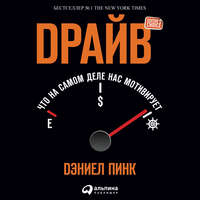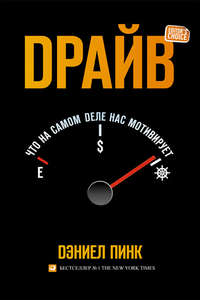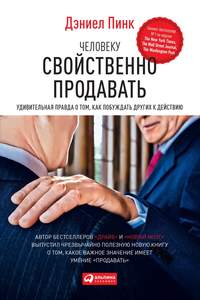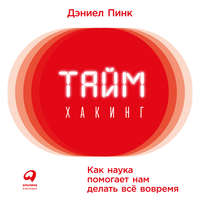
Полная версия
Таймхакинг. Как наука помогает нам делать всё вовремя
12
Arthur A. Stone et al., “A Population Approach to the Study of Emotion: Diurnal Rhythms of a Working Day Examined with the Day Reconstruction Method,” Emotion 6, no. 1 (2006): 139–149.
13
Jing Chen, Baruch Lev, and Elizabeth Demers, “The Dangers of Late-Afternoon Earnings Calls,” Harvard Business Review, October 2013.
14
Jing Chen, Baruch Lev, and Elizabeth Demers, “The Dangers of Late-Afternoon Earnings Calls,” Harvard Business Review, October 2013.
15
Jing Chen, Elizabeth Demers, and Baruch Lev, “Oh What a Beautiful Morning! Diurnal Variations in Executives’ and Analysts’ Behavior: Evidence from Conference Calls.” (Электронная версия: https://www.darden.virginia.edu.uploadedfiles/darden_web/content/faculty_research/seminars_and_conferences/CDL_March_2016.pdf.)
16
Jing Chen, Elizabeth Demers, and Baruch Lev, “Oh What a Beautiful Morning! Diurnal Variations in Executives’ and Analysts’ Behavior: Evidence from Conference Calls.” (Электронная версия: https://www.darden.virginia.edu.uploadedfiles/darden_web/content/faculty_research/seminars_and_conferences/CDL_March_2016.pdf.)
17
Amos Tversky and Daniel Kahneman, “Extensional Versus Intuitive Reasoning: The Conjunction Fallacy in Probability Judgment,” Psychological Review 90, no. 4 (1983): 293–315.
18
Galen V. Bodenhausen, “Stereotypes as Judgmental Heuristics: Evidence of Circadian Variations in Discrimination,” Psychological Science 1, no. 5 (1990): 319–322.
19
Galen V. Bodenhausen, “Stereotypes as Judgmental Heuristics: Evidence of Circadian Variations in Discrimination,” Psychological Science 1, no. 5 (1990): 319–322.
20
Russell G. Foster and Leon Kreitzman, Rhythms of Life: The Biological Clocks That Control the Daily Lives of Every Living Thing (New Haven, CT: Yale University Press, 2005), 11.
21
Carolyn B. Hines, “Time-of-Day Effects on Human Performance,” Journal of Catholic Education 7, no. 3 (2004): 390–413, citing Tamsin L. Kelly, Circadian Rhythms: Importance for Models of Cognitive Performance, U. S. Naval Health Research Center Report, no. 96–1 (1996): 1–24.
22
Simon Folkard, “Diurnal Variation in Logical Reasoning,” British Journal of Psychology 66, no. 1 (1975): 1–8; Timothy H. Monk et al., “Circadian Determinants of Subjective Alertness,” Journal of Biological Rhythms 4, no. 4 (1989): 393–404.
23
Robert L. Matchock and J. Toby Mordkoff, “Chronotype and Time-of-Day Influences on the Alerting, Orienting, and Executive Components of Attention,” Experimental Brain Research 192, no. 2 (2009): 189–198.
24
Hans Henrik Sievertsen, Francesca Gino, and Marco Piovesan, “Cognitive Fatigue Influences Students’ Performance on Standardized Tests,” Proceedings of the National Academy of Sciences 113, no. 10 (2016): 2621–2624.
25
Nolan G. Pope, “How the Time of Day Affects Productivity: Evidence from School Schedules,” Review of Economics and Statistics 98, no. 1 (2016): 1–11.
26
Mareike B. Wieth and Rose T. Zacks, “Time of Day Effects on Problem Solving: When the Non-optimal Is Optimal,” Thinking & Reasoning 17, no. 4 (2011): 387–401.
27
Lynn Hasher, Rose T. Zacks, and Cynthia P. May, “Inhibitory Control, Circadian Arousal, and Age,” в Daniel Gopher and Asher Koriat, eds., Attention and Performance XVII: Cognitive Regulation of Performance: Interaction of Theory and Application (Cambridge, MA: MIT Press, 1999), 653–675.
28
Cindi May, “The Inspiration Paradox: Your Best Creative Time Is Not When You Think,” Scientific American, March 6, 2012.
29
Mareike B. Wieth and Rose T. Zacks, “Time of Day Effects on Problem Solving: When the Non-optimal Is Optimal,” Thinking & Reasoning 17, no. 4 (2011): 387–401.






